Flower Carpet, Brussels
Over 500,000 flowers!
Scents, colours, lights and sounds…
Every other summer, on the weekend of August 15th, the Flower Carpet offers a chance to stroll across the Grand-Place, a jewel of Gothic architecture, to inhale the fragrant scent of the begonias and admire its details. This extraordinary spectacle is made complete by a visit to the balcony of the Town Hall, which offers a wide-angle view of the work. A musical theme is especially composed for each edition. A concert is given on the Grand-Place every evening and accompanies a magnificent sound-and-light show.

Begonia tuberosa grandiflora
The robust tuberous begonia lends beauty and freshness to the carpet. A native of the West Indies, the hearty begonia is resistant to all weather conditions: intense sunshine, violent winds, rain, cold . . . Begonias come in a rich palette ranging from the most vivid colours to delicate pastel shades, with in between the many-coloured and white flowers that reflect sunlight so well. Belgium is the world’s largest producer of begonias: 35 million bulbs each year! 80% of the total production, cultivated almost exclusively in the area of Ghent since 1860, is exported, primarily to the Netherlands, the United States, the United Kingdom, France and Germany.

A long creative process…
Every two years, the non-profit association Tapis de Fleurs brings together a committee of professionals (illustrators, graphic designers, landscape architects) who come up with scale projects, with each edition illustrating a different theme (the commemoration of major events, a country, a continent, the coat of arms of a city, etc.). Once the theme has taken shape in the form of a model and symbols, the number of flowers is calculated and the combinations of colours are established. The hundreds of thousands of cut flowers necessary for the composition can then be reserved, very long in advance. Several days before the inauguration, a full-size drawing is executed on sheets of micro-perforated plastic that are laid down atop the cobblestones of the Grand-Place. The works can then begin.
… For a marvellous ephemeral work
More than 100 volunteer gardeners put together this giant floral puzzle in less than eight hours. The day before the opening, the spaces between the floral motifs are filled in using rolls of sod. The flowers are so closely-packed that they can´t be blown away, and indeed they create their own microclimate! If there´s a heat wave, the sod is watered to prevent it from wilting. If the weather is too wet, the grass can grow by 4 to 5 centimetres in 3 days. The flowers remain fresh and preserve their splendour during the four days.

A first Flower Carpet on Brussels´ Grand-Place in 1971
This was the work of the landscape architect Etienne Stautemas, born in Zottegem in 1927. A graduate of the Horticultural College of Ghent, he began to create flower carpets in the early 1950´s. Simpler, smaller, these “rugs” were primarily composed of begonias which he loved and with which he worked ever since. After years of testing and calculations, the team of Etienne Stautemas, together with designer Mark Schautteet, imposed itself as the specialist in the creation of immense flower carpets, with sophisticated colours and complicated designs. The team went on to create more than 180 carpets, in Ghent, Bruges, Cologne, Luxembourg, Paris, London, Amsterdam, The Hague, Vienna, Valencia and even Buenos Aires and Columbus (Ohio). But “nowhere else is the carpet as magnificent and distinguished as on the ancient and unique Grand-Place of Brussels”.
The Grand-Place, a Unesco world heritage site
This is the historical heart of Brussels. Here Gothic style can be seen adjacent to opulent baroque, neo-classical as well as neo-Gothic. The Grand-Place is regarded by its admirers as “the most beautiful central square in the world”! Its construction began in the 15th century, with halls, guild houses and a Town Hall. It was virtually razed after 3 full days of bombardment by the French Army in 1695, yet was rebuilt in less than 5 years, notably by the different guilds. The tower of the Town Hall is 96 metres high. Every two years, the Flower Carpet offers a chance to (re)discover this architectural and cultural heritage jewel. Since 2000 the entire Grand-Place has been listed as a Unesco world heritage site.
2018:
“Guanajuato, cultural pride of Mexico”
This carpet featured cultural elements from the state of Guanajuato, Mexico. Including symbolism from the Chupícuaro, Otomí and Purépecha cultures. In addition to the begonias, the carpet included dahlias, the national flower of Mexico.
Just like Brussels, this colourful state in Central Mexico has a rich tradition in tapestry. The annual highlight is “La Octava Noche” in the southern city of Uriangato, where the locals decorate kilometres of streets with carpets of coloured sawdust. It is the most important event for ephemeral art in the centre of Mexico.
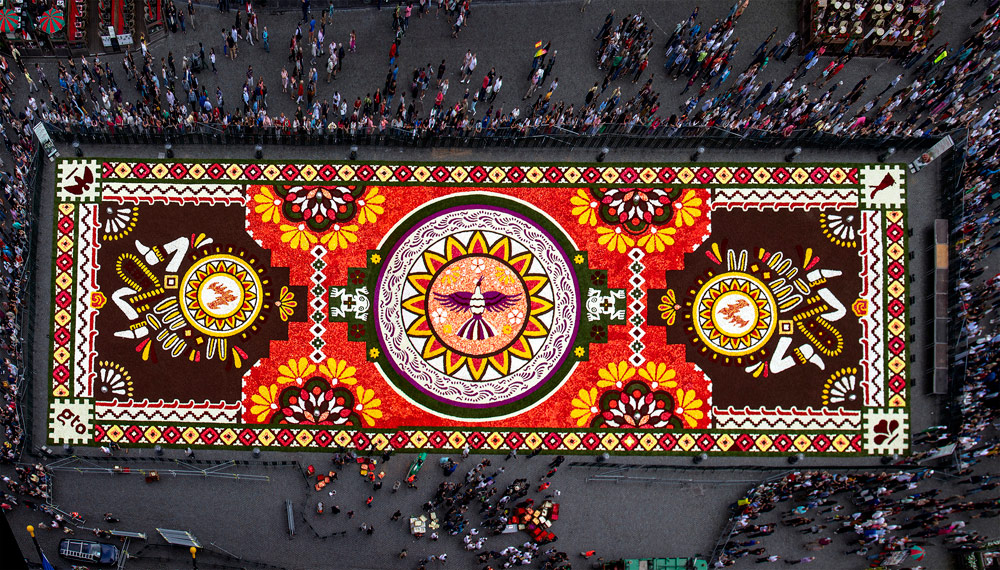
2016:
A 20th Flower Carpet on the theme of Japan to celebrate 150 years of Belgo-Japanese friendship!
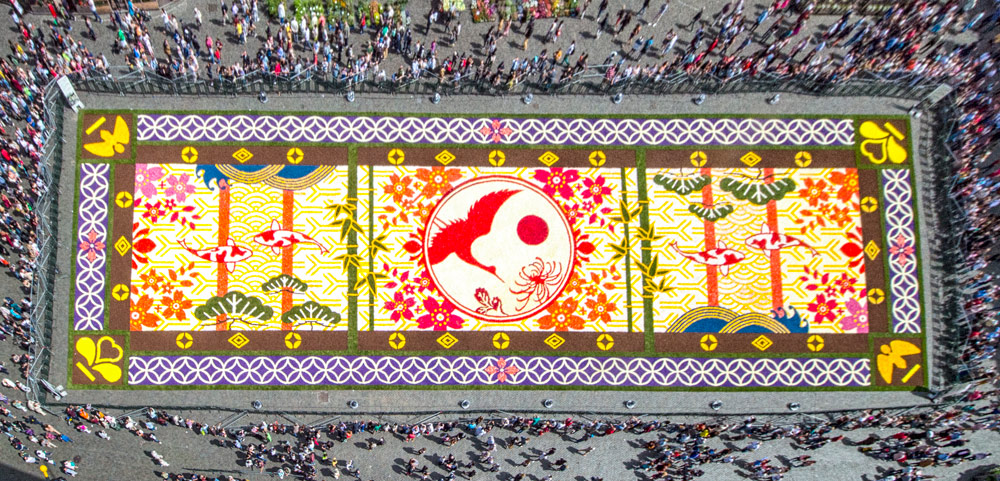
2014:
On the occasion of this 19th edition, the Flower Carpet of the Grand-Place has chosen to celebrate the 50th anniversary of Turkish immigration in Belgium. Turks came to Belgium in 1964 when both countries signed a bilateral treaty welcoming immigrants during the economic boom.
1,800 m2 of begonias (begonyas in Turkish) will make up an ephemeral tapestry inspired by the geometric patterns of Turkey’s famous kilims.
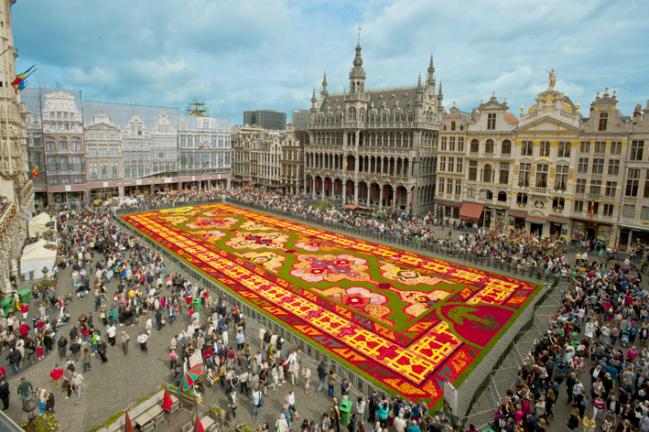
2012:
Africa honoured at the Grand-Place of Brussels.
An extraordinary tapestry of shimmering patterns recalling designs from the tribes of Ethiopia, Congo, Nigeria, Botswana, and Cameroun. This carpet exhibited the colours of Africa, inspired by traditional fabrics and tribal costumes.
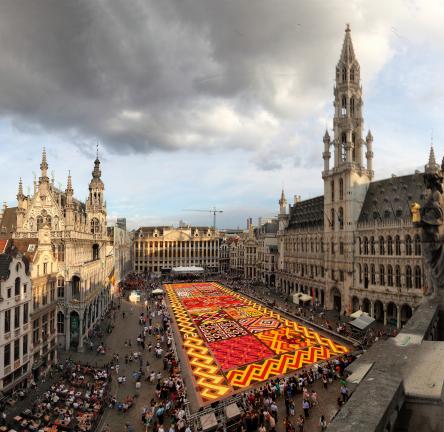
2010:
Honouring the Belgian presidency of the European Union
The designers of this tapestry honored Belgian Herman Van Rompuy, the first president of the European Union, with images of historic Belgian symbols alongside the European Union logo.
On two opposite corners, there is Saint Michael striking down the dragon. This is the protective image of the city of Brussels which was founded over 1,000 years ago. On the other two corners, there is the stylised image of the yellow and blue iris, the emblem of the region. Between the two, there is an evocation of Gothic architecture representing the splendid surrounding buildings.
“In the very centre, at three different angles, the elegant EU logo will be displayed. It is the work of Antoine Durieux, a young, 23 year old Belgian designer. It is no coincidence that twelve fountains enhance and refresh the whole ensemble. The chosen number of stars of Europe may, for example, combine four spatial dimensions and the three sacraments. Think of all the other interpretations and applications of this basic “twelve” configuration.”
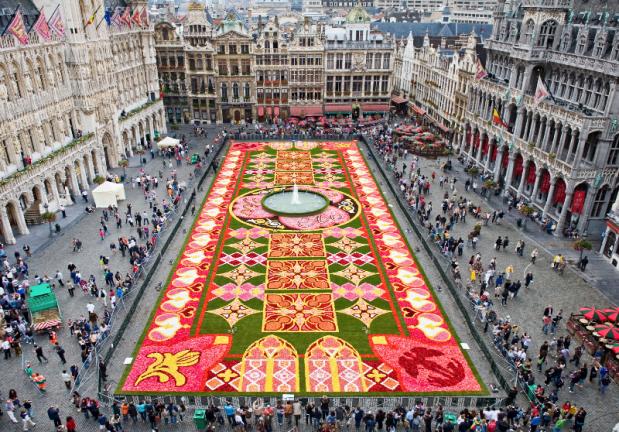
2008:
A royal flamboyance!
The patterns were inspired by 18th-Century French designs and colours.
“The history of French tapestry is unique. Why did it develop so rapidly and with such talent shortly after 1600? Because the ceaseless conflicts of the age made all trade with the East quite chancy, even very risky. The kings of France supported important local workshops, where craftsmen mastered the complex and intertwined patterns in palettes of glistening colours. Their products went immediately to grace the immense reception rooms of royal palaces whose official emblems they bore. Like the fleur-de-lys, which is happily related to the famous symbolic iris of Brussels. But also garlands of roses and acanthus leaves, evocations of fruits and horns of plenty…. An abundant composition that will leave no-one indifferent.”
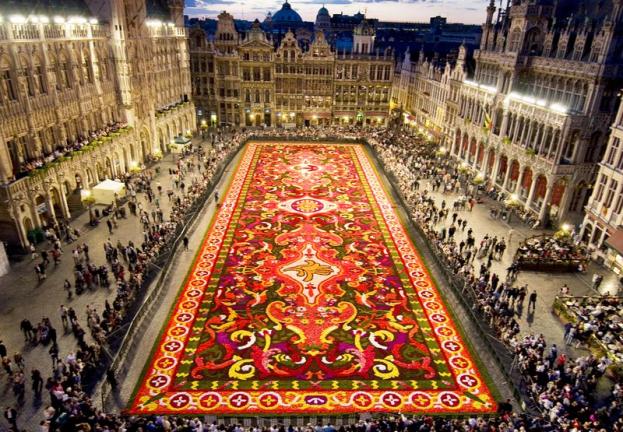
Brussels Flower Carpet
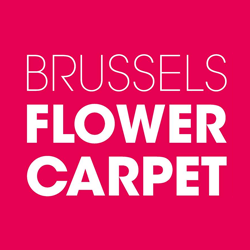
PROFILE
The Flower Carpet is 70 m long by 24 m wide. 1,680 m2 of begonias, dahlias, grass and bark.
A hundred volunteers assemble the carpet in less than eight hours.
The first Flower Carpet of Brussels was created in 1971 and has been a showstopper every two years on the Grand-Place since 1986.
